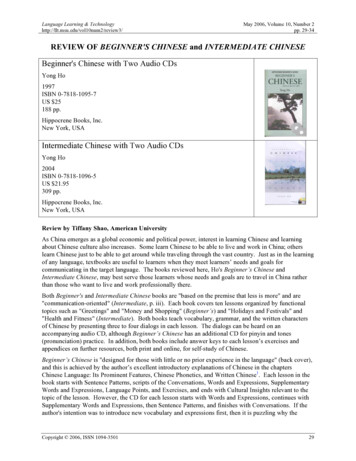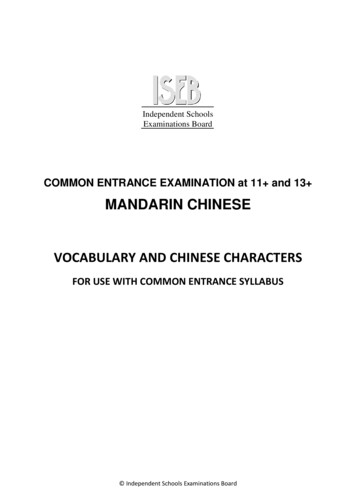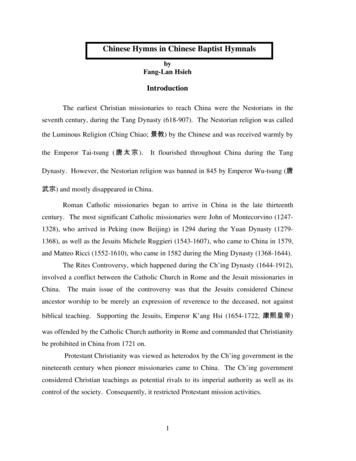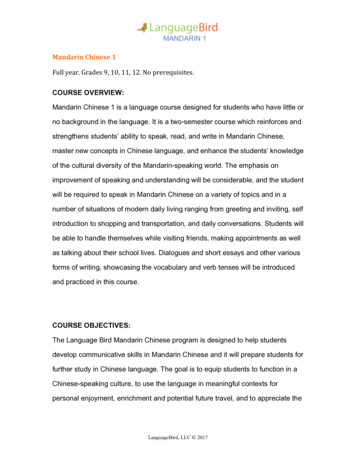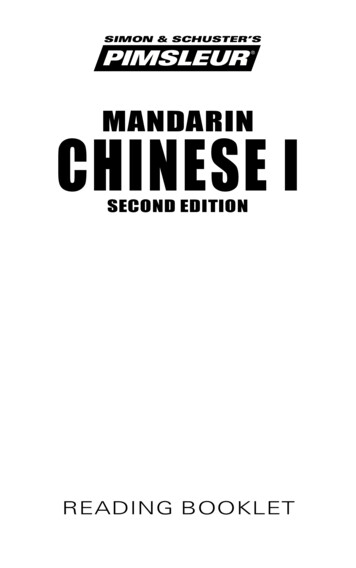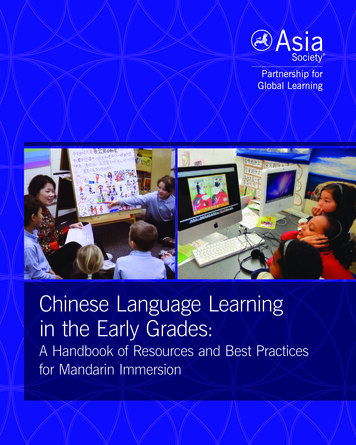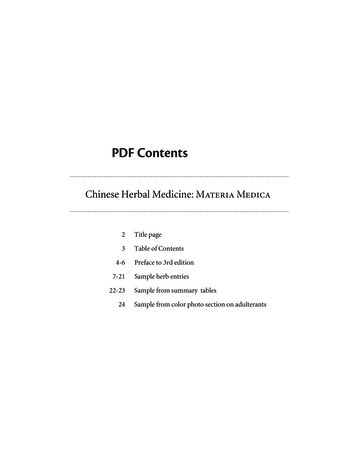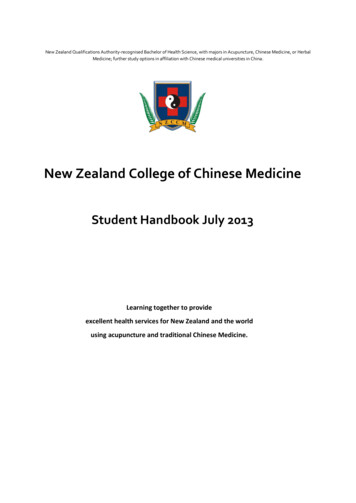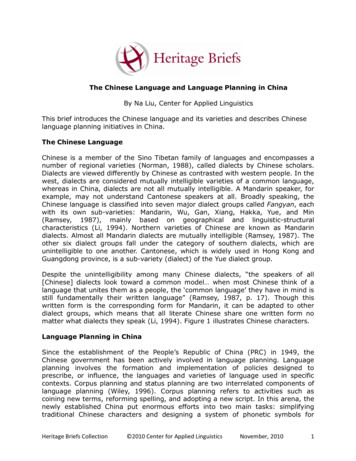
Transcription
The Chinese Language and Language Planning in ChinaBy Na Liu, Center for Applied LinguisticsThis brief introduces the Chinese language and its varieties and describes Chineselanguage planning initiatives in China.The Chinese LanguageChinese is a member of the Sino Tibetan family of languages and encompasses anumber of regional varieties (Norman, 1988), called dialects by Chinese scholars.Dialects are viewed differently by Chinese as contrasted with western people. In thewest, dialects are considered mutually intelligible varieties of a common language,whereas in China, dialects are not all mutually intelligible. A Mandarin speaker, forexample, may not understand Cantonese speakers at all. Broadly speaking, theChinese language is classified into seven major dialect groups called Fangyan, eachwith its own sub-varieties: Mandarin, Wu, Gan, Xiang, Hakka, Yue, and Min(Ramsey, 1987), mainly based on geographical and linguistic-structuralcharacteristics (Li, 1994). Northern varieties of Chinese are known as Mandarindialects. Almost all Mandarin dialects are mutually intelligible (Ramsey, 1987). Theother six dialect groups fall under the category of southern dialects, which areunintelligible to one another. Cantonese, which is widely used in Hong Kong andGuangdong province, is a sub-variety (dialect) of the Yue dialect group.Despite the unintelligibility among many Chinese dialects, “the speakers of all[Chinese] dialects look toward a common model when most Chinese think of alanguage that unites them as a people, the „common language‟ they have in mind isstill fundamentally their written language” (Ramsey, 1987, p. 17). Though thiswritten form is the corresponding form for Mandarin, it can be adapted to otherdialect groups, which means that all literate Chinese share one written form nomatter what dialects they speak (Li, 1994). Figure 1 illustrates Chinese characters.Language Planning in ChinaSince the establishment of the People‟s Republic of China (PRC) in 1949, theChinese government has been actively involved in language planning. Languageplanning involves the formation and implementation of policies designed toprescribe, or influence, the languages and varieties of language used in specificcontexts. Corpus planning and status planning are two interrelated components oflanguage planning (Wiley, 1996). Corpus planning refers to activities such ascoining new terms, reforming spelling, and adopting a new script. In this arena, thenewly established China put enormous efforts into two main tasks: simplifyingtraditional Chinese characters and designing a system of phonetic symbols forHeritage Briefs Collection 2010 Center for Applied LinguisticsNovember, 20101
Mandarin Chinese. Status planning has been linked to the official recognition thatnational governments attach to various languages (Cooper, 1989). From the 1950‟s,one of the chief goals of status planning in China was to standardize and promoteMandarin Chinese as the common spoken language of the PRC (Zhou, 2001).Corpus planningThe Chinese language is notorious for its difficulty as a written language. In modernChinese there is an average of eleven strokes per character, and the configurationsof these strokes are complex (Chen, 1999). Because the graphic shape of thecharacters provides little indication of their pronunciation, learning to read andwrite thousands of graphically complex characters becomes a massive mnemonictask. It is estimated that 30 percent of the total class hours in Chinese elementaryand secondary school education are devoted to learning the Chinese language, andmuch of the time is spent on learning characters (Chen, 1999). After theestablishment of the PRC in 1949, the country was faced with low literacy amongthe population. In order to eliminate mass illiteracy, the government activelysupported the simplification of Chinese traditional characters. On October 10, 1949,The Chinese Script Reform Association was established, to be succeeded by theCommittee for the Reform of the Chinese Written Language on December 23, 1954(Rohsenow, 2004). A complete list of 2,236 simplified characters, the General Listof Simplified Characters, was published in 1964. This list was republished in 1986with minor revisions and is now the official standard (Rohsenow, 2004). Figure 1contrasts traditional and simplified characters. Currently, simplified Chinesecharacters are adopted in the PRC and Singapore, while in Taiwan and Hong Kong,traditional characters are used.Traditional 語見charactersSimplified 语见charactersEnglishLanguage ishRedFigure 1: Traditional and Simplified Chinese CharactersThe Romanization of the Chinese writing system was another task in new China‟scorpus planning. In 1951, Chairman Mao pointed out that Chinese characters mustbe reformed and based on an alphabetic script like most of the world‟s writingsystems (Zhou, 2004). By 1958, the Hanyu Pinyin Scheme to represent thepronunciation of Mandarin was completed as planned and approved by the NationalPeople‟s Congress. In the Hanyu Pinyin Scheme, Roman alphabets (used in English)were used to represent Chinese sounds (Lam, 2005). Many of the designers ofHanyu Pinyin had high hopes that this Romanized alphabetic system would evolveinto a full-fledged independent writing system to exist side by side with, or eveneventually replace, the system of Chinese characters. Nevertheless this system,now almost a half century old, remains officially only a system for annotating andteaching the sounds of standard Mandarin and the Chinese characters (Rohsenow,2004).Heritage Briefs Collection 2010 Center for Applied LinguisticsNovember, 20102
Figure 2 illustrates how Hanyu Pinyin represents pronunciation of Chinesecharacters.Hanyu PinyinyǔjiànChinese characters 语见(simplified)EnglishLanguage rMealFishRedFigure 2: Hanyu Pinyin and Chinese charactersStatus planningThe national government of China has been promoting Mandarin as the officiallanguage since its establishment. Mandarin dialects are spoken by about 70 percentof the Chinese population (Norman, 1988). This vast number of speakers provides avalid foundation for Mandarin as the common language of China. Before Mandarinwas officially adopted on October 26, 1955, People’s Daily published an editorial,“Strive to promote the reform of the Chinese script, the spread of Mandarin, andthe standardization of Chinese.” The editorial shows that the official position in the1950s was that Mandarin was advocated on public occasions. At the beginning of1956, Mandarin Chinese was officially adopted as the common language, Putonghua,for the PRC (Guo, 2004). On September 14, 1998, the People’s Daily published acommentary titled “To promote Mandarin vigorously.” This language policy wasimplemented into language practices by different mechanisms. According toShohamy (2005), these mechanisms include laws, rules and regulations, languageeducation policies, language tests, and language use in public spaces.The first law in the PRC on language and script was passed on July 5, 2000, titled“Law of the People‟s Republic of China on the National Commonly Used Languageand Script.” Before the passage of the law, the working group carried out extensiveinvestigations of language and script use in thirty cities and counties throughoutChina‟s major metropolitan regions, provinces, and autonomous regions, as well asof language laws in other countries (Rohsenow, 2004). In the formulation andevolution of the language law, a realistic understanding of the limits of “socialengineering” resulted in allowing daily use of local varieties, combined withpromotion of Mandarin and simplified Chinese characters. Increased use ofMandarin by government officials and in public interactions is encouraged, but notharshly enforced by unrealistic, excessive measures; use of dialects in necessaryand appropriate situations is authorized. The rights of China‟s minorities to maintaintheir spoken languages and scripts are affirmed. With this language law passed,Mandarin was promoted in public and formal situations by local governments. Forexample, the local dialect of Shanghai, which is not mutually intelligible withMandarin, is the preferable language by most Shanghainese and used on thestreets and in the workplace. However, the metropolis is working on a campaign topromote standard Mandarin and Chinese characters in the workplace. According tothe new policy, only Mandarin should be used on occasions like the official activitiesof government, lessons in schools and other educational institutions, radio andtelevision broadcasting, and films and TV dramas (Pan, 2005).Heritage Briefs Collection 2010 Center for Applied LinguisticsNovember, 20103
As for language education policies, from the autumn of 1956, except for in ethnicminority regions, all elementary and secondary schools should begin to include theteaching of Mandarin in Chinese classes. From 1960, students from grade three andabove, secondary school students, and those in teacher training colleges should beable to speak Mandarin. Mandarin should be used as a medium of instruction inelementary schools and teacher training colleges for all subjects. Younger teachersand teaching assistants in higher education should enroll in short Mandarin coursesif they do not speak Mandarin (Lam, 2005).In the 1980s, the move toward standardization in assessing proficiency in Mandarinwas proposed at a 1986 national conference, and the standards were distributed inDecember 1997. The standards describe six levels of proficiency in reading andconversation. A Mandarin proficiency test in line with the standards is intended fornative speakers of Chinese, with particularly high requirements for broadcastingpersonnel and teachers. In the meantime, a test for non-native speakers wasdesigned by the State Leading Group for Teaching Chinese as a Foreign Languageto coordinate the teaching of Chinese to non-native speakers within and outsideChina. In 1988, this national standardized test, called the Hanyu Shuiping Kaoshi(HSK or Chinese Proficiency Test of China) was established to measure the Chineseproficiency of foreigners, overseas Chinese, and non-native speakers of Chinesefrom ethnic minorities in China (Lam, 2005).ConclusionThe Chinese language is not one variety, but rather includes a number of regionaldialect families. Since the establishment of the People‟s Republic of China in 1949,the government has launched several language planning initiatives, including butnot limited to simplifying Chinese characters, designing a system of phoneticsymbols for Mandarin, and promoting Mandarin as the common language of China.ReferencesChen, P. (1999). Modern Chinese: History and sociolinguistics. Cambridge:Cambridge University Press.Cooper, R. L. (1989). Language planning and social change. Cambridge: CambridgeUniversity Press.Guo, L. (2004). The relationship between Putonghua and Chinese dialects. In M.Zhou & H. Sun (Eds.), Language policy in the People’s Republic of China:Theory and practice since 1949 (pp. 45-53). Norwell, MA: Kluwer AcademicPublishers.Lam, A. S. L. (2005). Language education in China: Policy and experience from1949. Hong Kong: Hong Kong University Press.Heritage Briefs Collection 2010 Center for Applied LinguisticsNovember, 20104
Li, W. (1994). Three generations, two languages, one family: Language choice andlanguage shift in a Chinese community in Britain. Clevedon, UK: MultilingualMatters.Norman, J. (1988). Chinese. Cambridge, UK: Cambridge University Press.Pan, H. (Sept. 9, 2005). Proud Shanghainese asked to speak putonghua. ChinaDaily. Retrieved Dec. 7th, 2006, 9/29/content 481647.htmRamsey, S. R. (1987). The languages of China. Princeton, NJ: Princeton UniversityPress.Rohsenow, J. S. (2004). Fifty years of script and written language reform in thePRC: The genesis of the language law of 2001. In M. Zhou & H. Sun (Eds.),Language policy in the People’s Republic of China: Theory and practice since1949 (pp. 21-43). Norwell, MA: Kluwer Academic Publishers.Shohamy, E. (2005). Language policy: Hidden agendas and new approaches.London & New York: Routledge Taylor & Francis Group.Wiley, T. G. (1996). Language planning and language policy. In S. McKay & N.Hornberger (Eds.), Sociolinguistics and language teaching (pp. 103-147).Cambridge: Cambridge University Press.Zhou, Y. G. (2001). Language planning of China. Journal of Asian PacificCommunication, 11(1), 9-16.Zhou, Q. (2004). Writing creation and nation establishment. In M. Zhou & H. Sun(Eds.), Language policy in the People’s Republic of China: Theory andpractice since 1949 (pp. 55-70). Norwell, MA: Kluwer Academic Publishers.This Heritage Brief was prepared by Dr. Na Liu for the Alliance for the Advancementof Heritage Languages, Center for Applied Linguistics (CAL), Washington DC.The Heritage Briefs Collection is designed to provide information on topics ofinterest. The information presented does not necessarily represent the views of theAlliance for the Advancement of Heritage Languages or the Center for AppliedLinguistics.Visit us online at www.cal.org/heritageHeritage Briefs Collection 2010 Center for Applied LinguisticsNovember, 20105
China. In 1988, this national standardized test, called the Hanyu Shuiping Kaoshi (HSK or Chinese Proficiency Test of China) was established to measure the Chinese proficiency of foreigners, overseas Chinese, and non-native speakers of Chinese from ethnic min
